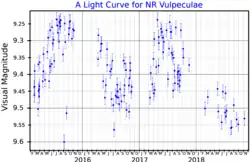| Observation data Epoch J2000 Equinox J2000 | |
|---|---|
| Constellation | Vulpecula |
| Right ascension | 19h 50m 11.9280s[2] |
| Declination | 24° 55′ 24.1775″[2] |
| Apparent magnitude (V) | 9.13 - 9.61[3] |
| Characteristics | |
| Evolutionary stage | Red supergiant[4] |
| Spectral type | M1Ia[3] |
| Variable type | LC[3] |
| Astrometry | |
| Proper motion (μ) | RA: −2.320±0.073[2] mas/yr Dec.: −5.807±0.071[2] mas/yr |
| Parallax (π) | 0.5633 ± 0.0516 mas[2] |
| Distance | 5,800 ± 500 ly (1,800 ± 200 pc) |
| Details | |
| Mass | 4.92[5] M☉ |
| Radius | 553[6] R☉ |
| Luminosity | 111,000[7] - 223,000[4] L☉ |
| Surface gravity (log g) | −0.13[5] cgs |
| Temperature | 3,986±170[6] K |
| Metallicity [Fe/H] | +0.093[5] dex |
| Other designations | |
| Database references | |
| SIMBAD | data |
NR Vulpeculae is a red supergiant and irregular variable star in the constellation Vulpecula. It has an effective temperature around 4,000 K, a radius of 553 times larger than the sun, which means that if it were in the place of the Sun, its surface would reach beyond Mars's orbit. Consequently, NR Vulpeculae is also a luminous star, radiating 111,000 - 223,000 times as much energy as the sun. It is considered a likely member of the Vulpecula OB1 stellar association.[8]
References
- ↑ "ASAS-SN Variable Stars Database". ASAS-SN Variable Stars Database. ASAS-SN. Retrieved 6 January 2022.
- 1 2 3 4 5 Brown, A. G. A.; et al. (Gaia collaboration) (August 2018). "Gaia Data Release 2: Summary of the contents and survey properties". Astronomy & Astrophysics. 616. A1. arXiv:1804.09365. Bibcode:2018A&A...616A...1G. doi:10.1051/0004-6361/201833051. Gaia DR2 record for this source at VizieR.
- 1 2 3 NR Vul, database entry, The combined table of GCVS Vols I-III and NL 67-78 with improved coordinates, General Catalogue of Variable Stars Archived 2017-06-20 at the Wayback Machine, Sternberg Astronomical Institute, Moscow, Russia. Accessed on line November 12, 2010.
- 1 2 Dorn-Wallenstein, Trevor Z.; Levesque, Emily M.; Neugent, Kathryn F.; Davenport, James R. A.; Morris, Brett M.; Gootkin, Keyan (2020), "Short-term Variability of Evolved Massive Stars with TESS. II. A New Class of Cool, Pulsating Supergiants", The Astrophysical Journal, 902 (1): 24, arXiv:2008.11723, Bibcode:2020ApJ...902...24D, doi:10.3847/1538-4357/abb318, S2CID 221340538
- 1 2 3 Anders, F.; Khalatyan, A.; Chiappini, C.; Queiroz, A. B.; Santiago, B. X.; Jordi, C.; Girardi, L.; Brown, A. G. A.; Matijevič, G.; Monari, G.; Cantat-Gaudin, T.; Weiler, M.; Khan, S.; Miglio, A.; Carrillo, I.; Romero-Gómez, M.; Minchev, I.; De Jong, R. S.; Antoja, T.; Ramos, P.; Steinmetz, M.; Enke, H. (2019). "Photo-astrometric distances, extinctions, and astrophysical parameters for Gaia DR2 stars brighter than G = 18". Astronomy and Astrophysics. 628: A94. arXiv:1904.11302. Bibcode:2019A&A...628A..94A. doi:10.1051/0004-6361/201935765. S2CID 131780028.
- 1 2 Messineo, M.; Brown, A. G. A. (2019). "A Catalog of Known Galactic K-M Stars of Class I Candidate Red Supergiants in Gaia DR2". The Astronomical Journal. 158 (1): 20. arXiv:1905.03744. Bibcode:2019AJ....158...20M. doi:10.3847/1538-3881/ab1cbd. S2CID 148571616.
- ↑ Mauron, N.; Josselin, E. (2011). "The mass-loss rates of red supergiants and the de Jager prescription". Astronomy and Astrophysics. 526: A156. arXiv:1010.5369. Bibcode:2011A&A...526A.156M. doi:10.1051/0004-6361/201013993. S2CID 119276502.
- ↑ Levesque, Emily M.; Massey, Philip; Olsen, K. A. G.; Plez, Bertrand; Josselin, Eric; Maeder, Andre; Meynet, Georges (August 2005). "The Effective Temperature Scale of Galactic Red Supergiants: Cool, but Not As Cool As We Thought". The Astrophysical Journal. 628 (2): 973–985. arXiv:astro-ph/0504337. Bibcode:2005ApJ...628..973L. doi:10.1086/430901. S2CID 15109583.
This article is issued from Wikipedia. The text is licensed under Creative Commons - Attribution - Sharealike. Additional terms may apply for the media files.
